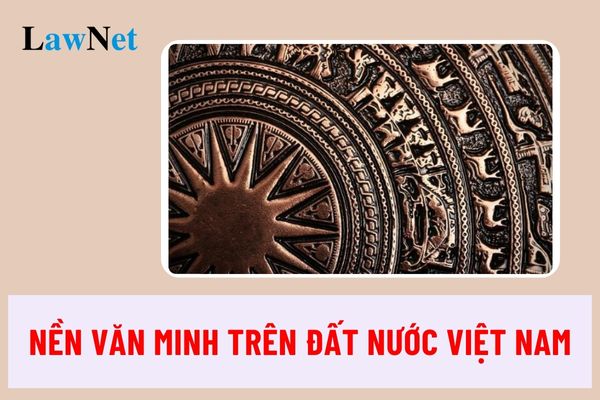Content on Civilizations in Vietnam before 1858 according to the New General Education Program
What are civilizations in Vietnam according to the new general education program?
Based on Section 5 of the History General Education Program issued with Circular 32/2018/TT-BGDDT, several civilizations in Vietnam before 1858 and the requirements as per the New Program are as follows:
| Content | Required Achievements |
| Some Ancient Civilizations in Vietnam Red River Civilization |
- Ability to collect and use historical materials to learn about the Red River civilization. |
| - Foundation Formation | - State the foundation of the Red River civilization: natural conditions, social foundation, etc. |
| - Key Achievements | - State the key achievements of the Red River civilization: material life, spiritual life, social organization, state, etc. |
| Champa Civilization - Foundation Formation - Key Achievements |
- State the foundation of the Champa civilization. - Present the key achievements of the Champa civilization: material life, spiritual life, social organization, state, etc. |
| Funan Civilization - Foundation Formation - Key Achievements |
- State the foundation of the Funan civilization. - Present the key achievements of the Funan civilization: material life, spiritual life, social organization, state. - Apply understanding of the above ancient civilizations to introduce Vietnam's land and people. Recognize the enduring value of ancient civilizations in Vietnam. - Appreciate the tradition of diligent and creative labor of the Vietnamese people in history. Take responsibility in contributing to the preservation of the nation's cultural heritage. |
| Dai Viet Civilization Foundation Formation and Development Process of Dai Viet Civilization |
|
| - Concept of Dai Viet Civilization - Foundation Formation - Development Process |
- Explain the concept of Dai Viet civilization. - Analyze the foundations of the Dai Viet civilization: inheriting the Van Lang - Au Lac civilization, the country's independence and autonomy, absorbing Chinese cultural influences. - State the development process of the Dai Viet civilization over time. |
| Some Achievements of Dai Viet Civilization - Economy - Politics - Ideology, Religion - Culture, Education, Literature, Arts |
- Ability to collect and use historical materials to learn about the achievements of the Dai Viet civilization. - State some basic achievements of the Dai Viet civilization in economy, politics, ideology, religion, culture, education, literature, arts, etc. |
| The Significance of Dai Viet Civilization in Vietnamese National History | |
| - Strengths and Limitations of Dai Viet Civilization | - State remarks on the strengths and limitations of the Dai Viet civilization. |
| - The Significance of Dai Viet Civilization in Vietnamese National History | - Analyze the significance of the Dai Viet civilization in Vietnamese national history. - Appreciate the value of the Dai Viet civilization, apply understanding to introduce and promote Vietnam's land, people, and cultural heritage. |

Content on Civilizations in Vietnam before 1858 according to the New General Education Program (Image from the Internet)
Which group does the History subject belong to? What are the characteristics of the History subject in the new program in Vietnam?
Based on Section 1 of the History General Education Program issued with Circular 32/2018/TT-BGDDT regulating the characteristics of the History subject, History is part of the Social Sciences group, selected based on career orientation at the upper secondary school level.
In addition, some other characteristics:
History Subject aims to help students develop historical competence, a component of scientific competence, while contributing to the development of the essential qualities and general competencies defined in the Comprehensive Program.
History plays a leading role in educating patriotism, national pride, historical and cultural traditions, helping students recognize and apply historical lessons to solve real-life problems, expand horizons, consolidate human values, community spirit, tolerance, benevolence; contributing to the formation and development of the qualities of Vietnamese citizens and global citizens in the development trend of the era.
History fosters historical thinking, system thinking, critical thinking, skills in exploiting and using historical sources, understanding and presenting history in chronological order and synchronicity, connecting the past with the present.
History helps students recognize the scientific and practical value of history in modern social life, develop a love for national and human history and culture; orient students towards careers such as social sciences and humanities research, diplomacy, management, tourism, cultural industries, information, and communication.
The History curriculum systemizes, consolidates historical knowledge in the basic education phase and helps students delve deeper into core historical knowledge through thematic and specialized topics on world history, Southeast Asian history, and Vietnamese history.
The teaching method of the History subject is implemented on the foundation of the basic principles of historiography and modern educational methods.
Is the History curriculum in Vietnam designed to Be open and articulate?
Based on Section 2 of the History General Education Program issued with Circular 32/2018/TT-BGDDT, the History curriculum is designed to be open and articulate. To be specific:
(1) The structure of knowledge and skills in the History subject allows students to connect and integrate with knowledge and skills from other subjects such as Geography, Literature, Civics, National Defense and Security Education, etc.;
(2) The program grants autonomy to localities and schools to develop educational plans suited to local conditions, promotes creativity among teachers in implementing the policy of "one program, multiple textbooks"; emphasizes the coordination between schools, families, and society in historical education;
(3) The program ensures high integration in lower grades, gradual differentiation in upper grades; closely connects grade levels within each educational stage and articulates with vocational and higher education programs.

